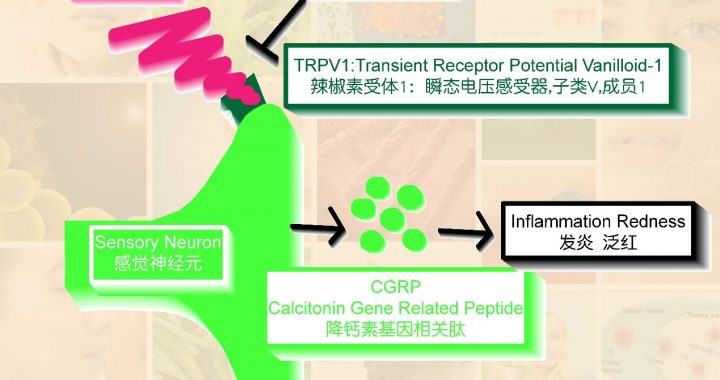PhotoGel represents a new method of biophotonic skin rejuvenation. PhotoGel is a type of gel for partial use to improve the whole look of skin, intended for professional beauty care. Continue reading
Category Archives: Wrinkle tight
Bio-Skinflora Solution
Description: nutrient solution with strong capacities of moisture retention, soothing allergies and anti-irritation
Innovative Mechanism:
Plant collagen, glucan and prebiotics work together to form a highly hydrophilic micro-ecological protective membrane on the skin, which protects, repairs and strengthens the first defensive line for skin.
With a strong hydrophilic feature, phytocollagen is a very good natural moisturizing ingredient. Unlike general covering moisturizer, Plant collagen can promote the keratinocytes of skin to produce a natural moisturizing factor (NMF), which exerts a moisturizing effect, penetrates and infiltrates the stratum corneum, making the skin more transparent and moisturized, and forming a skin self-protection mechanism. This will enhance skin elasticity, eliminate small wrinkles, improves the texture of skin, and isolates external toxic and harmful substances.
The natural water-soluble yeast β-glucan can bind to the receptor CR3 of yeast β-glucan on the Langerhans cells in the epidermis, activate macrophages, and produce various cytokines (e.g., IL-1, IL-6, GM-CSF), epidermal growth factor (EGF), tumor necrosis factor (TNF-α) and angiogenic factors (AF), etc., thus improving skinimmunity. Yeast glucan also has the function of anti-inflammation, anti-allergy, eliminating free radical, moisturizing and accelerating stratum corneum renewal, which helps the skin resist external mechanical and chemical stimuli and facilitates the recovery of injuries. An increase in epidermal growth factor can promote the production of collagen and elastin, thus improving the exterior of skin and eliminating fine line wrinkles.
Prebiotics promotes the growth of epidermal probiotics through selective nutrient supply mechanisms, inhibits the growth of harmful flora through competitive mechanisms, establishes and maintains a stable and healthy skin micro-ecological system, maintains healthy skin pH, and reduces inflammation and allergic reactions. .
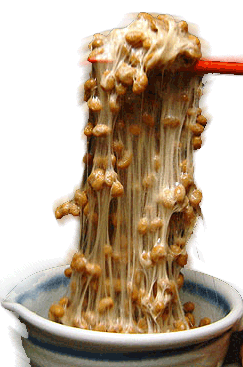
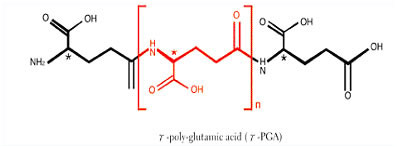
Fermentation-derived Phytocollagen

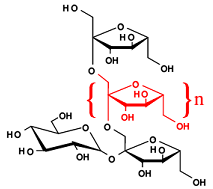
Plant-derived Fructan and Fructose Oligomers
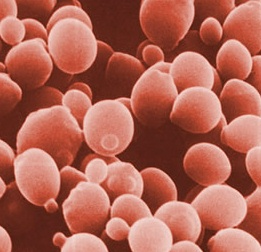
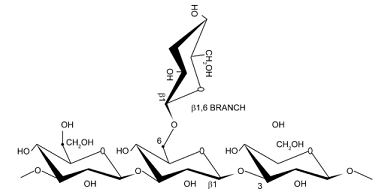
Yeast-derived Glucan
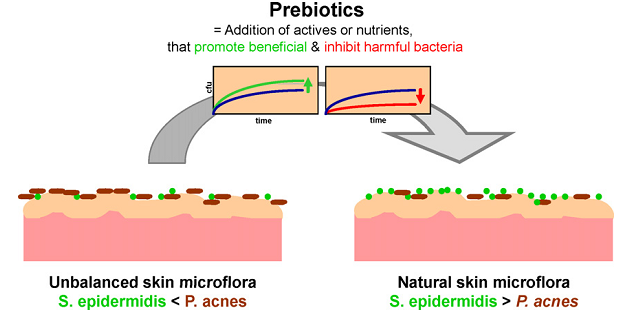
Prebiotics can improve skin micro-ecological balance
Applications:
- Sensitive skin: protecting the skin from external stimuli, soothing allergies and anti-inflammation
- Dry skin: moisturizing, wrinkle-reducing, anti-aging, improving skin texture
- Anti-acne&pimple: inhibiting the growth of harmful microbes such as propionibacterium acnes, promoting the growth of skin probiotics, establishing a healthy micro-ecological system, and regulating the pH value of skin health.
- Infant care: prevention on infection (especially for the areas wrapped with diaper)
- Other skincare and haircare products.
Instruction for Prescription
Solubility: This product is easily soluble in water
Recommended dosage: The product is added in an amount of 1-10%. It is recommended to add this below 60℃ in the final stage of cosmetic production. It is compatible with a wide range of cosmetic ingredients.
NanoSmooth
Abstract: NanoSmooth is a new multi-effect skin care active product that developed by using a new type of nanochannel delivery technology which combines anti-inflammatory, anti-itching, and antibacterial healing active compounds such as plant polyphenols and dihydro-o-alkali alkaloids. This skin care active has the functions of repairing barrier, evening skin color, reducing fever and redness, etc
As people’s awareness of health and environmental protection enhances, active matter derived from plants is getting more and more attention. Plant polyphenols (PPs) are a kind of substance that plants produce to resist natural enemies, competitors, infections and physical injuries. Currently, over 8000 kinds of plant PPs have been discovered. Plant PPs’ abilities of UV absorption, anti-oxidation, radical clearance, metal complexation and antibiosis functions are similar among plants, animals and humans. Many PPs also have the activity of anti-inflammation, anti-allergy, micro-circulation facilitation, anti-tumor, etc., thus are widely being used in fields such as medicine, functional food and cosmeceuticals. The first plant medicine approved by FDA is VEREGEN, a tea polyphenol ointment. The annual sales amount of salvia polyphenol acid salt that Shanghai Green Valley cure cardiovascular diseases through injection has exceeded one billion yuan.
The unique physical, chemical and biological properties enable the plant PPs to be a natural skin protector against the injuries caused by UV (e.g. inflammation, light aging and canceration) as well as the antibiotics against skin fungus and bacterial infection. Besides, there are many important phenylalanine metabolites in human bodies (e.g. estrogen, thyroxine, tyrosine and dopamine), which are quite similar to the plant PPs derived from phenylalanine. Hence, plant PPs used in human bodies can easily enter the metabolism channel, replacing or competing with endogenous phenylalanine metabolites. This provides a theoretical basis for the plant PPs skincare products that include the functions of brightening, anti-aging, anti-acne, anti-alopecia, brightening and anti-hypertrichosis. As for the anti-inflammation effect closely combined with facilitating the recovery of injuries, not only is it attributed to the anti-oxidation, radical clearance, metal complexation, etc., of plant PPs, but also it depends on the interaction between plant PPs and regular inflammatory cells (e.g. keratinocyte) and collected inflammatory cells (e.g. granulocyte, lymphocyte and dendritic cells) of skin. From the perspective of molecular biology, plant PPs restrain the expression and activation of many pro-inflammatory enzymes by reacting with certain surface receptors, and regulating signal transmission channels and inflammation reaction. The extensive molecular targets make plant PPs become the most promising partly applied active matter for anti-inflammation, anti-allergy and injury recovery. Plant PPs can induce the production of enzymes that eliminate carcinogenic toxin and restrain harmful substance from converting into the final carcinogenic enzymes, thus detoxifying and preventing cancers.
The main problems that hinder the application of plant PPs in cosmetics are the chemical instability, interaction with other ingredients, low permeability and fast metabolism in skin. NanoSmooth, developed through nano-medicine technology, solves the above problems well while maintaining the original biological activity of the plant polyphenols so that it can be applied to varieties of cosmetics.
TRPV1 channel, also known as capsaicin receptor, chemical components such as capsaicin, pH<6, temperature>42°C and substance P (SP) can activate the channel, causing cations such as Ca2+inflow and K+outflow. This results in the release of SP and calcitonin gene related peptide (CGRP), causing nociceptive pain [9]. Many TRPV1 channel modulators, including natural products, have been shown to effectively alleviate pain in a variety of animal models, and TRPV1 has become an important target standard for the development of analgesic drugs.
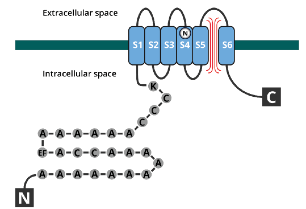
Capsaicin receptor protein structure
So far, more than 100 natural regulators targeting TRP channels have been found in nature, including alkaloids, terpenoids, phenols, peptides, flavonoids, etc., involving more than 70 species of animals and plants. Most of the modulators increase or decrease intracellular Ca2+levels by activating or inhibiting TRP channels, resulting in desensitization of nerve endings, induction of endogenous release, etc. Animal tests have demostrated that actives have abilities such as analgesia, anti-inflammation and nervous system protection, etc.
Scientific research shows that plant polyphenols such as resveratrol and gallnut extract are safe and efficient TRPV1 antagonists, which play an anti-inflammatory and analgesic role. Japanese scientist Yoshihito Shimazu et al. showed that the analgesic effect of partial use topical 10 mM resveratrol is comparable to 37 mM (1%) lidocaine (Brain Research Bulletin, http://dx.doi.org/10.1016/j.brainresbull.2016.06.001).

NanoSmooth targets TRPV1 target mechanism
Dihydrotomatine alkaloids are derived from the active ingredient of oats (Avenasativa) and have rapid anti-inflammatory and anti-itching activity. Studies have shown that oat alkaloids have multifunctional anti-inflammatory activity, including inhibition of keratinocyte nuclear factor NF-κB-α degradation directly related to inflammation, preventing phosphorylation of p65 protein subunit on nuclear factor NF-κB, thereby blocking the process of breaking cell inflammation; reducing the incidence of inflammatory immune response and skin neurodermatitis. Oat alkaloids inhibit TNF-alpha and induce activity of NF-kappa B degrading enzymes, reduce inflammatory factors and lead to the release of atopic dermatitis IL-8. At a low concentration of 30 ppm, oat alkaloids can greatly reduce the number of itching from contact dermatitis and neurodermatitis. The above evidence indicates that oat alkaloids have potent anti-inflammatory and anti-itch properties and are the potent non-steroidal anti-inflammatory and anti-itching natural ingredient with a potency comparable to hydrocortisone without any side effects of steroid hormones.
Tranilast is a drug very similar to the structure of dihydroolaline alkaloids and has powerful effects on: anti-inflammatory, anti-allergic, anti-irritation, fast anti-itching, antihistamine, immunomodulation, anti-fibrosis (anti-scarring), anti-erythema.
NanoSmooth can exert multiple effects such as antihistamine, anti-oxidation, anti-irritant, anti-inflammatory, and erythema and especially good at relieving sensitive skin, itching, irritation, redness, etc. The recommended dosage range from 0.5% to 5.0%.
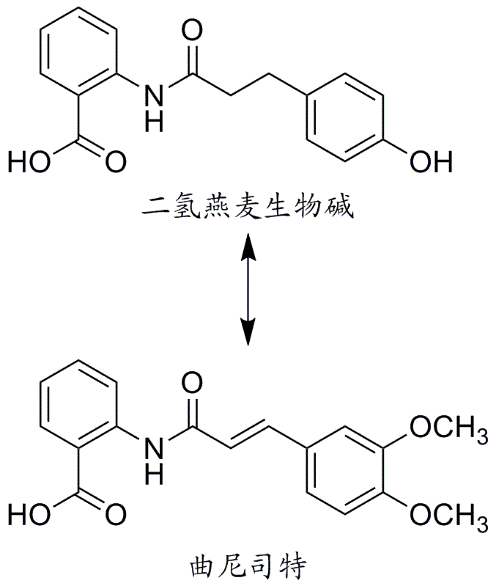
Dihydrotomatine alkaloids and Tranilast structure
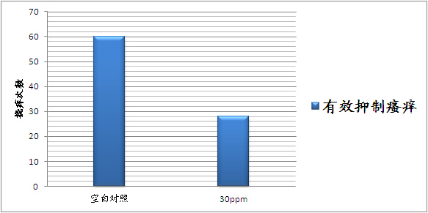
NanoSmooth can effectively suppress itching
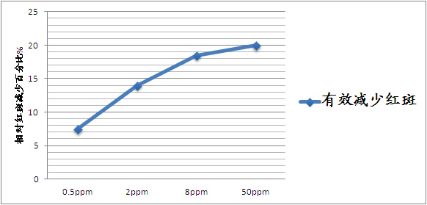
NanoSmooth can effectively reduce erythema
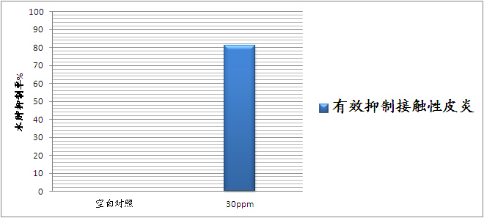
NanoSmooth can effectively inhibit contact dermatitis

NanoSmooth can effectively inhibit contact dermatitis
NanoSmooth developed by nanoChaneel Delivery System(NDS), completely solves the solubility problem of biopolyphenols and dihydrotomatine alkaloids. The active substances are stably encapsulated in nanocarriers, which are convenient for application, difficult to precipitate, and can significantly increase absorption efficiency and bioavailability.
Use : Adding at the low temperature stage, recommended dosage: 0.5-5.0%.
Storage: Keep it away from light at a temperature below 25℃.
NanoActive RAL
Nanoactive RAL, INCI name: Retinal, CAS: 116-31-4.
Product Name: Nanoactive RAL, BioaActive Retinaldehyde; BioActive Retinal; Soluble Retinal; Soluble Retinaldehyde;Nano Liposomal
Nanoactive RAL is a novel retinal nanoliposome formulation (NanoLiposomal RAL).
A new liposome preparation. RAL has the characteristics of retinoic acid in the skin, and is better tolerated than retinoic acid. It directly interacts with protein receptors in cells, stimulates epidermis to accelerate regeneration, increases the thickness of the stratum corneum, and makes the skin tighter and more orderly. It also accelerates the production of collagen in the dermis layer, prevents the damage of UV to collagen, inhibits the increase of MMP caused by UV, and makes the skin more elastic; the unique aldehyde-based structure has a very good effect on P. acnes, etc., and effectively improves acne skin. Large amounts of retinal, retinol, retinol retinate (15498-86-9), HPR(893412-73-2) and other Vitamin A kind products of pharmaceutical grade are available.
Description:
Retinaldehyde (RAL), also known as vitamin A aldehyde, is a derivative of retinol after oxidation. It is formed by oxidative cleavage of β-carotene. If reduced, retinol can be attained; If oxidized, retinoic acid can be attained.Retinoic acid。”. The role of retinoic acid (Vitamin A) in skin diseaseis very extensive, but due to local irritation, its clinical application is limited to some extent.Retinaldehyde is an intermediate metabolite of natural retinoic acid and has similar biological activity as retinoic acid. But the skin is significantly more tolerant to retinoic acid.
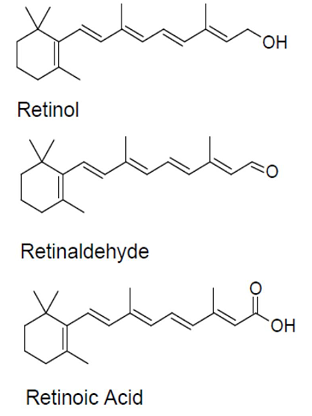
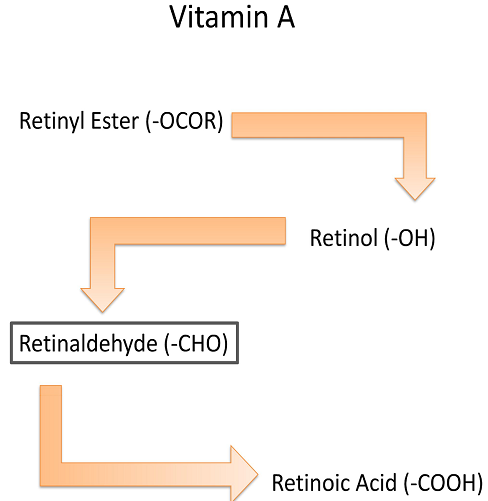
The main forms of vitamin A and their interconversion
Retinal has many target on the skin. It can be used as a skin care product to produce a variety of effects such as anti-aging, skin rejuvenation, whitening, anti-wrinkle, acne, keratin, etc. It is an emerging high-efficiency natural active substance. Retinal is hardly soluble in water while easy to be oxidized and discolored, which limits its application in cosmetics. Nano actives with a particle size of less than 30 nm developed by nano-transmission system (NDS) enable retinals to be steadily wrapped in nano-carriers, greatly improving the absorption efficiency and bioavailability. This overcomes the original defects and maintain the advantages and enables a more convenient and wider range of uses.
Skin care effect
The large use of non-physiological doses of exogenous retinoic acid can cause an overload of the retinoic acid-dependent pathway in the skin, causing adverse reactions such as skin irritation. RAL is a natural metabolite of retinol and a direct precursor of retinoic acid, and it also has similar biological activity to retinoic acid. The advantage of RAL compared with retinoic acid is its multi-directional metabolism, that is, the excess RAL can be rapidly reduced to retinol, then stored and inactivated in the form of retinol, and this “reverse metabolism” is not present in retinoic acid. After it is absorbed by the skin, most of it is converted to retinol vinegar stored for slow release, and a small amount of RAL is oxidized to retinoic acid by keratinocytes in differentiation-dependent manner, while a very small amount of retinoic acid is can exert significant biological effects in cells. This can avoid skin adverse reactions caused by high doses of retinoic acid. Clinical observations also show that topical RAL creams are well tolerated compared with retinoic acid and can be applied to sensitive areas. The topical RAL cannot absorbed by human blood. The levels of various vitamin A acids in the blood also cannot be affected.
RAL needs to be activated by the conversion of enzymes in keratinocytes to retinoic acid, so RAL has similar biological activity as retinoic acid. One of the indicators of retinoic acid activity is to induce the expression of retinoic acid binding protein (CRABP-2) in cells. External RAL can evidently induce the expression of CRABP-2 mRNA and protein. The topical natural retinoic acidcan also induce the expression of nuclear receptor in retinoic acid . Like retinoic acid, RAL also functions to regulate cell proliferation and differentiation. It can increase epidermal DNA synthesis, increase epidermis thickness, induce 50kD keratin, and reduce 7OkD keratin mRNA expression. Inducing positive keratinization, reducing 65kD keratin mRNA expression, and increasing filaggrin and loricin mRNA expression. In addition, RAL is also involved in the regulation of neovascularization in the skin, inhibiting the production of vascular endothelial growth factor by keratinocytes. It can repair the elastic fibers and collagen damage induced by UVA. RAL is also capable of dissolving acne and the direct sterilizing effect towards propionibacterium acnes. Natural retinoic acid play an important role in epidermal differentiation, dermal remodeling and curing skin inflammation. Retinaldehyde as an important intermediate metabolite of natural retinoic acid has both biological activity similar to that of retinoic acid and is well tolerated by the skin, thus it is given wider application in cosmetics.
Retinaldehyde can repair elastic fiber and collagen loss caused by UV:
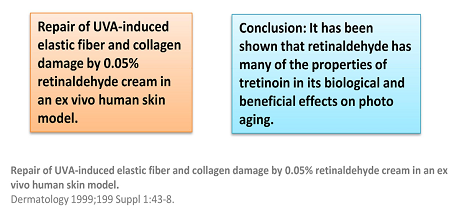
Retinaldehyde prevents skin aging caused by ultrasound and fluid
technology:
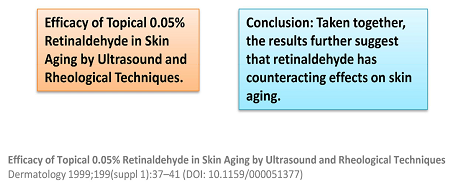
Retinaldehyde can effectively improve skin photoaging symptoms:
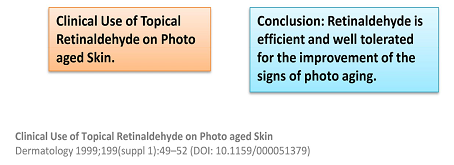
Retinaldehyde and retinal are well tolerated, while retinoic acid is more irritating
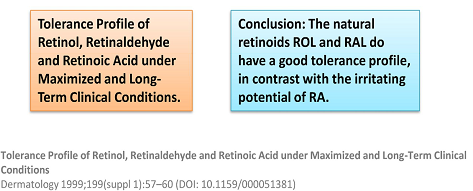
Retinaldehyde can effectively inhibit epidermal melanin
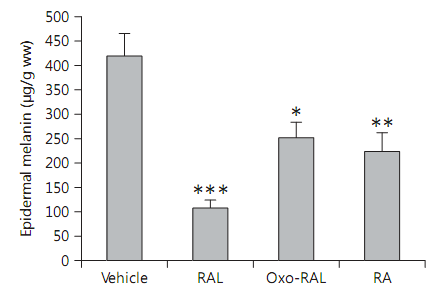
Features
- NanoActive Retinaldehyde uses FDA GRAS grade materials for high safety
- NanoActive Retinaldehyde has good heat, pH and sheer stability and is easy to use.
- NanoActive Retinaldehydegreatly enhances the stability and bioavailability of retinal
- NanoActive Retinaldehyde can improve the stability of other active matters in the product and facilitate absorption
- NanoActive Retinaldehyde is 100% water soluble and 100% oil soluble, allowing a wide range of uses.
Applications
- Wrinkle repairing: promote collagen and hyaluronic acid synthesis, increase skin thickness and elasticity, repair the wrinkle and firm the skin.
- Whitening and freckle removing: inhibit melanin synthesis, reduce pigmentation, whiten the skin and remove the freckle.
- Anti-aging: anti-oxidation, anti-skin-aging
- Skin-refreshing: renewal of keratin, refresh the skin.
- Acne Treatment: sterilizing propionibacterium acnes and streptococcus, etc., treating acne and removing acne marks
- Curing of skin photoaging
Use: Add it at room temperature; recommended dosage: 1-5% The optimum pH range of the system is 3.0-6.5, and the finished product should avoid direct exposure to sunlight (using opaque packaging). It is recommended to add UV absorber to day care products.
Storage: keep it away from light at a temperature below 25℃.

